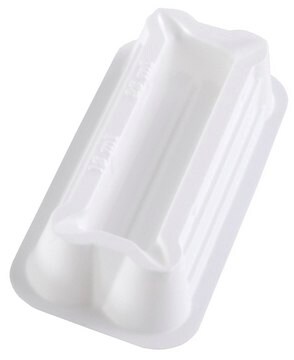15-105
mTOR phosphorylation Pathway Explorer Antibody MiniPack
This Antibody pack of Anti-mTOR antibodies contains Anti-phospho-mTOR Antibody(Ser2481), Anti-phospho-mTOR Antibody (Thr2446), Anti-phospho-mTOR (Ser2448).
Synonym(s):
FKBP12-rapamycin complex-associated protein 1, FKBP-rapamycin associated protein, Mammalian target of rapamycin, Rapamycin target protein, rapamycin associated protein FRAP2
About This Item
Recommended Products
biological source
rabbit
Quality Level
antibody form
affinity isolated antibody
purified by
affinity chromatography
manufacturer/tradename
Upstate®
technique(s)
activity assay: suitable
NCBI accession no.
UniProt accession no.
shipped in
dry ice
Gene Information
human ... MTOR(2475)
General description
Each Pathway Explorer Antibody Minipack contains three related antibodies as part of a signaling cascade or a combination of total and phosphorylated forms of key signaling targets. Each of the three antibodies are 30% the original pack size. Full size versions of each of the Pathway Explorer antibodies are available for sale individually under the same catalog number with the removal of “SP” off of each one (e.g. 05-591SP can be ordered as 05-591).
mTOR:
mTOR (Mammalian Target of Rapamycin, aka FRAP, RAPT or RAFT) is a large 289 kDa Ser/Thr protein kinase that regulates cell cycle progression, cell growth, protein synthesis, ribosome biogenesis, and autophagy. mTOR is an evolutionarily conserved member of the Phosphoinositol Kinase-related Kinase (PIKK) family whose activity is regulated by phosphorylation on Ser2448 by Akt in response to insulin or muscle activity. Interestingly, mTOR is the central component of two multimeric kinase complexes consisting of mTOR and numerous other mTOR binding proteins. These two multimeric protein complexes are designated mTORC1 and mTORC2. mTORC1 (mTOR Complex 1) consists of at least mTOR, Raptor, and GβL (mLST8). mTORC1 is known to play a central role in insulin signaling, which is crucial in maintaining metabolic homeostasis. The complex is activated primarily though the PI3 Kinase/Akt pathway. Upon insulin stimulation, Akt activates mTORC1 by phosphorylating and inhibiting TSC (and possibly other yet discovered targets and/or mTOR itself). This inhibits the upstream small GTPase regulator Rheb (Ras homolog enriched in brain). This inhibits the kinase activity of the mTORC1 complex, thus disabling its ability to phosphorylate its downstream targets such as p70 S6K on Thr389 and 4E-BP1 on Thr229. The other mTOR complex, mTORC2 (mTOR Complex 2), is made up of at least mTOR, Rictor, GL, Sin1, Protor 1 and 2. mTORC2 affects cell proliferation and survival primarily by phosphorylating the hydrophobic motif of Akt on Ser473, a well-known effecter of the PI3 Kinase pathway. In addition to phosphorylating Akt, the mTORC2 complex is also known to effect cytoskeletal organization and migration by exerting its effects through Rac, Rho, and PKC. Interestingly, unlike mTORC1, the mTORC2 complex appears to not be inhibited by treatment with rapamycin and for this reason is referred to as the rapamycin-insensitive complex. Defects in both mTOR complexes are associated with a variety of diseases, including cancer and diabetes.
*See full size versions for corresponding references.
Immunogen
09-213SP: phosphorylated Ser2448 of mTOR
09-343SP: phosphorylated Ser2481 of mTOR
Application
Signaling
Apoptosis & Cancer
PI3K, Akt, & mTOR Signaling
Glucose/Glycogen Metabolism
Insulin/Energy Signaling
Packaging
Components
09-345SP Anti-phospho-mTOR (Thr2446); 30 µL
09-213SP Anti-phospho-mTOR (Ser2448); 60 µL
Physical form
Legal Information
Disclaimer
Storage Class Code
10 - Combustible liquids
Regulatory Listings
Regulatory Listings are mainly provided for chemical products. Only limited information can be provided here for non-chemical products. No entry means none of the components are listed. It is the user’s obligation to ensure the safe and legal use of the product.
JAN Code
15-105:
Certificates of Analysis (COA)
Search for Certificates of Analysis (COA) by entering the products Lot/Batch Number. Lot and Batch Numbers can be found on a product’s label following the words ‘Lot’ or ‘Batch’.
Already Own This Product?
Find documentation for the products that you have recently purchased in the Document Library.
Our team of scientists has experience in all areas of research including Life Science, Material Science, Chemical Synthesis, Chromatography, Analytical and many others.
Contact Technical Service








